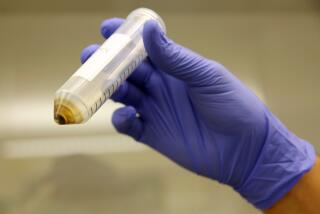Natural gas production contaminated drinking water in Texas, study finds
Natural gas production contaminated the well water of two homes in a Texas subdivision, according to a study published Monday.
The discovery came two years after the Environmental Protection Agency halted its investigation in the Parker County community over concern about costs and legal risks.
In the new study, scientists were trying to determine the origins of high methane levels in drinking water aquifers near gas wells in Pennsylvania and Texas. They found that water in the two homes had changed over nine months, going from containing trace amounts of methane to containing high levels.
The newly identified cases “caught this contamination in the act,” said Robert Jackson, a study coauthor and professor of environmental science at Stanford University.
The discovery challenges a long-standing assertion by the oil and gas industry that the U.S. energy boom has not damaged water supplies.
Other studies have found that water wells near natural gas production are more likely to contain methane. But the industry has contended that the methane found in water wells is naturally occurring and was there all along, before gas production began.
Each of 20 homes tested in Parker County has detectable methane in its well water because of many layers of oil and gas in the ground, the scientists said. Methane that enters homes through drinking water can pose an explosion risk if it accumulates in rooms or other spaces.
Two homes with water containing negligible amounts of methane in 2012 were tested again in August and November 2013, and showed far higher levels, the study said.
Further, the methane in the homes’ water no longer contained the chemical makeup of the naturally occurring trace gas, the study found. Instead, it had the same chemical fingerprint as natural gas deposits far below the aquifer.
“All the gas chemistry in the water changed so that it wasn’t just higher methane levels but higher methane from a totally different source,” said Thomas Darrah, assistant professor of earth sciences at Ohio State University and the study’s lead author.
Darrah and his colleagues concluded that the contamination occurred when natural gas from a lower geological depth migrated higher into drinking water sources because of a faulty cement job around the well. That allowed methane to leak into aquifers.
“The good news is that most of the issues we have identified can potentially be avoided by future improvements in well integrity,” Darrah said.
The study, published in the Proceedings of the National Academy of Sciences, spotlights the EPA’s controversial decision in 2012 to halt its investigation into possible well-water contamination in Parker County by the energy company Range Resources.
The EPA had gotten involved in 2010 because Range Resources and Texas regulators failed to act immediately on homeowners’ complaints of possible drinking water contamination, according to a 2013 report by the EPA inspector general. When the EPA conducted its own tests of well water in some Parker County homes, it found methane levels in the water of two homes that were high enough to pose an explosion risk, the report said.
The Justice Department filed a complaint on behalf of the EPA against Range in January 2011, but withdrew it by March 2012. The EPA and the Justice Department reversed course because the EPA was worried about the costs and legal risks of the case, the inspector general’s report said.
Texas authorities and Range Resources deny that the company’s gas development contaminated the water.
Matt Pitzarella, a spokesman for Range Resources, said company experts had not yet read the study. He cited previous tests by the company and Texas officials that “prove that the two Range wells could not have been the source of the gas in any water wells, nor did any other aspects of our work.”
The two Parker County homes that showed new contamination are near wells Range drilled in 2009 and sold in 2011 to Legend Natural Gas.
The new contamination was identified as part of a wider study that tested drinking water in 20 wells in Texas’ Barnett Shale area and 113 wells in Pennsylvania’s Marcellus Shale area.
In Texas, extremely high levels of methane were found in five homes, including the two whose contamination the researchers captured. In Pennsylvania, high levels of methane were found in 20 homes.
At least one house in Pennsylvania had a high level of methane that was there all along, unrelated to gas production. But for the other homes in both states, the chemical fingerprint of the methane at high levels in drinking water was the same as natural gas in deeper formations, the study said.
Responsibility for following up on the findings rests with Texas authorities, said Liz Purchia, an EPA spokeswoman, adding that the EPA is providing scientific assistance.
More to Read
Start your day right
Sign up for Essential California for news, features and recommendations from the L.A. Times and beyond in your inbox six days a week.
You may occasionally receive promotional content from the Los Angeles Times.







